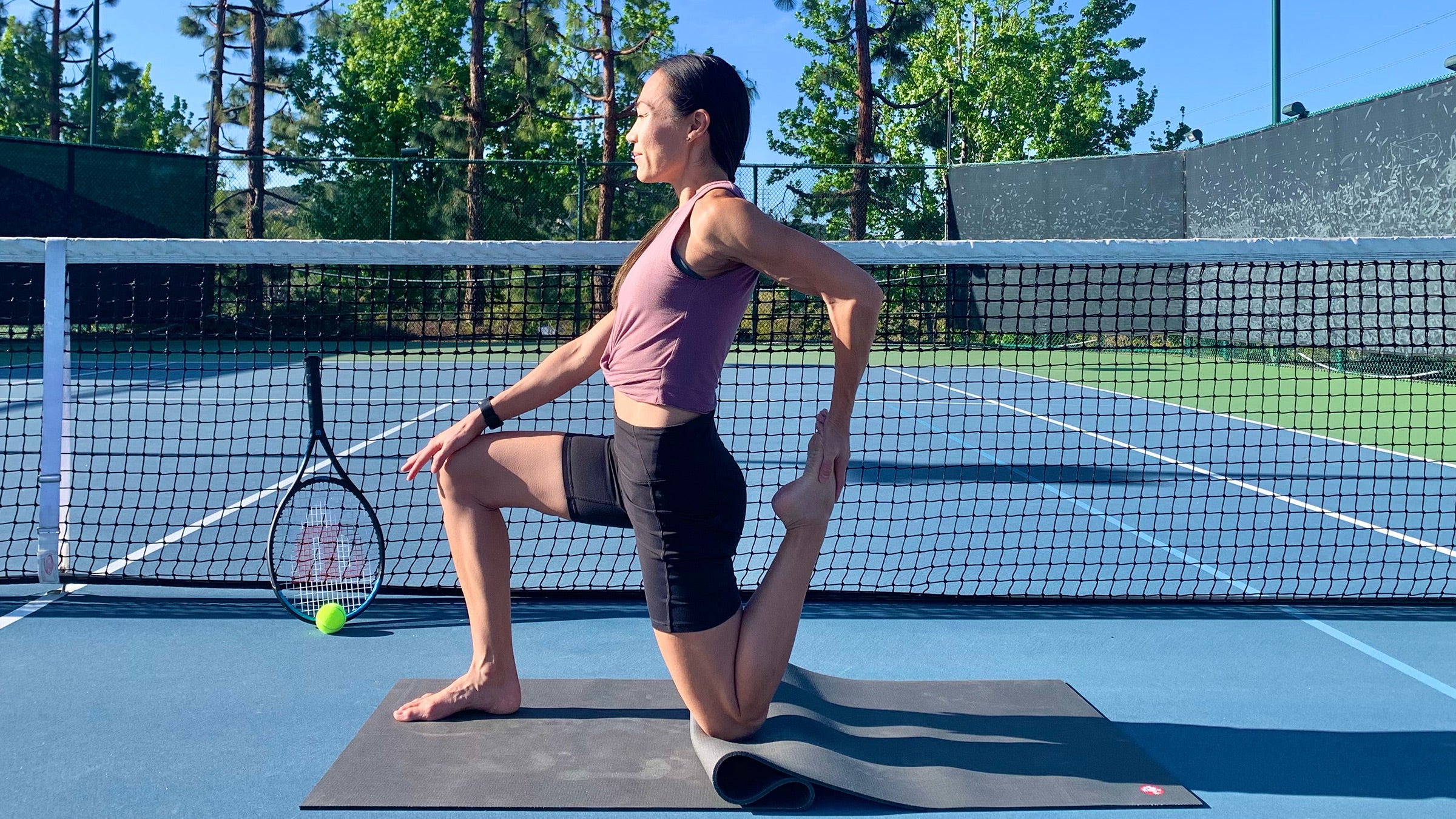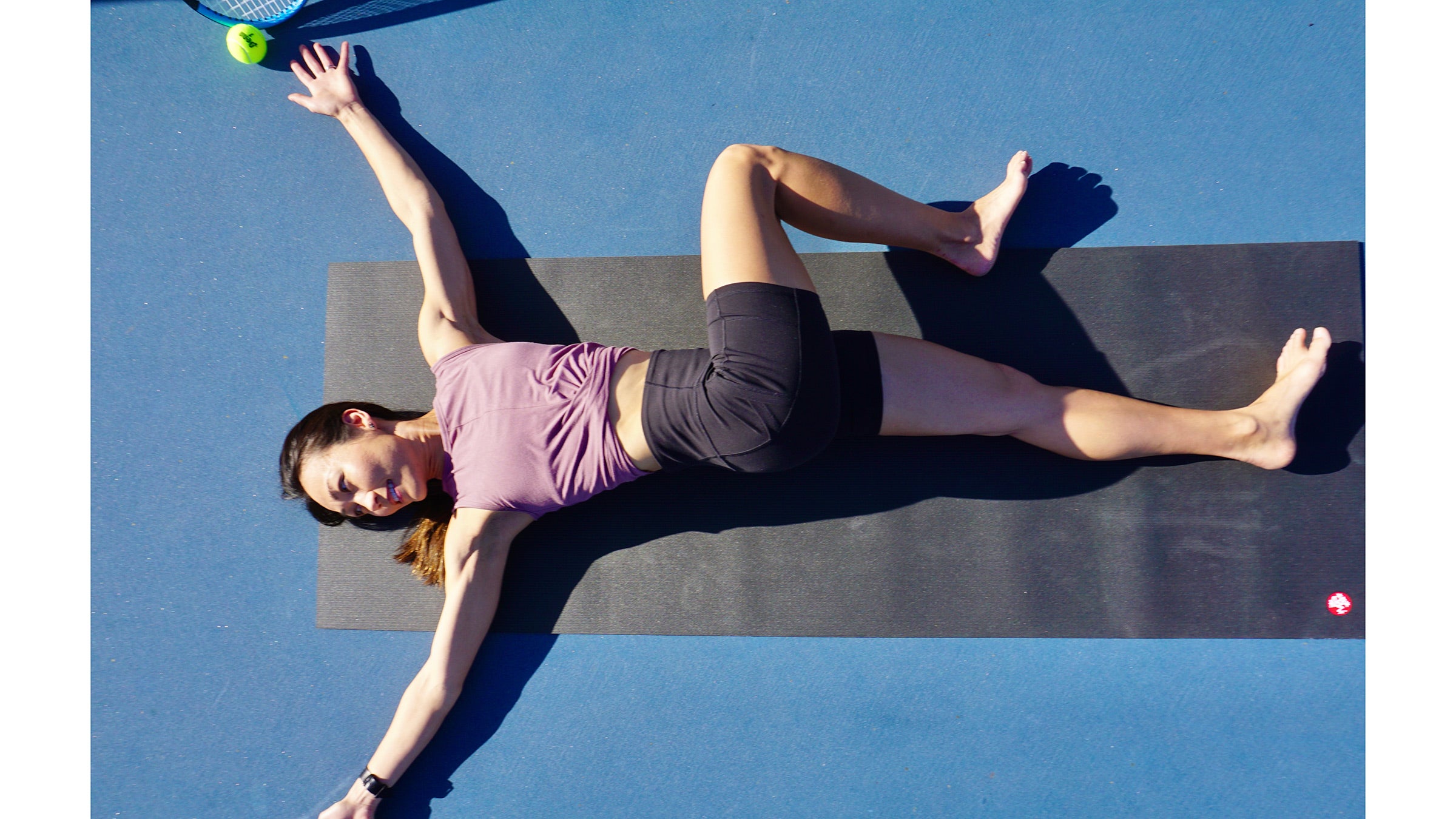Yoga for Tennis Players

Whassup, tennis titans! Ready to channel your inner Grand Slam champ with a little touch of yoga stretch-athlon? Whether you're volleying with vigor or hustling hard on the hardcourt, yoga and tennis go together like strawberries and cream at Wimbledon. It's time to unroll your yoga mat and serve up some ace poses with Everyday Yoga to enhance your game, soothe those swings, and keep your backhand as smooth as a Federer drop shot!
Grand Slam Yoga Moves for the Court Enthusiasts
Tennis is all about the swift sprints, dynamic dives, and killer serves, which means your body is in for quite the workout. But those match-winning moves can also lead to tight muscles, sore joints, and the dreaded T-word...tension. Yoga steps onto the court with a range of moves designed to stretch, strengthen, and balance tennis players from head to toe. It's the perfect cooldown partner after a grueling match or a pre-game warm-up to get your body game-set-match ready.
If you're looking for an intense strength-building practice, try Ashtanga, Bikram, or Vinyasa Yoga. If you'd like more emphasis on creating alignment and symmetry, try Iyengar or Hatha Yoga. Play around with different styles and teachers until you find a good fit.
Breathing Exercise: Three-Part Breath

A simple breathing exercise, Three Part Breath — Dirga Pranayama (DEER-gah prah-nah-YAH-mah) — brings your awareness to the present moment and calms your mind. This technique requires no special sound or position to achieve a relaxed and focused state of awareness.
- Sit or lie down in a comfortable position on the floor, in a chair, or on a bed.
- Place one hand on your belly and one hand on your rib cage.
- Close your eyes and breathe deeply, but naturally.
- Begin to focus your awareness on the breath as it moves in and out of your body.
- Feel the lift of your belly and the expansion of your ribs on your inhalations, and feel the slight compression of your ribs and the drop of your belly as you exhale.
- Next, bring your bottom hand to your chest, just below your collarbone. Breathe all the way into this area and allow your chest to rise slightly; then exhale and let it go.
- As you inhale, feel your belly lift, ribs expand, and chest lift. On your exhalations, notice how your chest drops, ribs contract, and belly lowers.
- Release your arms and focus your mind on your breath, inhaling and exhaling fully.
Full-body Stretch: Extended Triangle Pose
.jpg)
A standard pose in many yoga styles, Extended Triangle — Utthita Trikonasana (oo-TEE-tah tree-koh-NAH-suh-nuh) — tones the legs and stretches the hips, groins, and hamstrings. It also opens the chest and shoulders, and improves balance and coordination. It helps to relieve lower back pain, as well.
- Begin standing at the top of your mat. Turn to the left and step your feet wide apart. Extend your arms out to the sides at shoulder-height. Your feet should be as far apart as your wrists. Rotate your right (front) foot 90 degrees so your front foot's toes point to the top of the mat. Turn your left toes in slightly. Align your front heel with the arch of your back foot.
- Reach through your right hand in the same direction that your right foot is pointed. Shift your left hip back, and then fold sideways at the hip. Rest your right hand on your outer right shin or ankle. If you are more flexible, place your fingertips on the floor. You can also place your hand on a yoga block.
- Align your shoulders so your left shoulder is directly above your right shoulder. Gently turn your head to gaze at your left thumb.
- Hold for up to one minute. To release, inhale and press firmly through your left heel as you lift your torso. Lower your arms, change the position of your feet, and repeat on the opposite side.
Full-body Strength: Warrior II

A powerful standing pose, Warrior II — Virabhadrasana II (veer-uh-buh-DRAHS-uh-nuh) — increases stamina. It strengthens the quadriceps, calves, Achilles tendons, shoulders, and upper back. Additionally, it stretches the hips, groins, and chest; and helps to improve overall strength and balance.
- Stand with your feet wide apart. Point your right foot to the top of the mat, and turn your left foot slightly inward.
- Raise your arms parallel to the floor, reaching out actively from fingertip to fingertip.
- Bend your front knee to 90 degrees, making sure to keep your knee over your ankle. Press back through the outer edge of your left foot.
- Keep your torso perpendicular to the floor, lengthening the space between your shoulder blades and broadening across your collarbones.
- Draw your tailbone slightly downwards, and gaze out across your right middle finger. Hold for up to one minute. Repeat on the other side.
Standing Balance: Tree Pose

A popular balancing pose, Tree Pose — Vrksasana (vrik-SHAH-suh-nuh) — stretches the hips, thighs, torso, and shoulders. It builds strength in the ankles and calves, and helps to remedy flat feet. Additionally, it improves balance and coordination.
- Begin standing with your feet together. Slightly shift your weight to your left foot. Bend your right knee, then reach down and clasp your right ankle. Use your hand to draw your right foot alongside your inner left thigh. Do not rest your foot against your knee, only above or below it.
- Rest your hands on your hips and lengthen your tailbone toward the floor. Fix your gaze softly in front of you. Press your right foot into your left thigh.
- If you are comfortable balancing here, bring your hands together in prayer position at your chest. For a deeper pose, extend your arms above your head, reaching your fingertips towards the sky. To deepen your pose even more, try closing your eyes.
- Hold for up to one minute. Then step your feet together again and repeat on the opposite side.
Spinal Twist: Half Lord of the Fishes Pose

This seated spinal twist — Ardha Matsyendrasana (ARD-uh MAHT-see-ehn-DRAHS-uh-nuh) — helps to keep the spine, hips, and shoulder joints limber and flexible. It provides relief from fatigue and back pain, and calms the mind.
- Begin seated on the floor with your legs extended in front of you, arms resting at your sides. Bend both knees, placing the soles of your feet flat on the floor. Then, drop your left knee to the floor. Tuck your left foot under your right leg and rest your left foot alongside your right buttock.
- On an inhalation, raise your left arm overhead. Exhaling, twist to the right against the inside of your right thigh. Place your left elbow to the outside of your right knee. Keep your forearm raised, fingertips pointing toward the ceiling. To deepen the pose, lower your forearm and clasp your left knee. Reach behind your body and rest your right hand on the floor behind you.
- Spiral your torso around your spine from your tailbone to the crown of your head.
- With each inhalation, make your spine longer. With each exhalation, twist a little deeper.
- Turn your head to gaze over your right shoulder.
- Hold for up to one minute.
- To release, exhale and unwind your torso. Come back to center and extend both legs in front of you. Repeat the twist for the same length of time on the opposite side.
Serve and Stretch
Ever felt the tension in your shoulders after a killer serve? Enter yoga's shoulder-opening poses. The warrior series is not just for the mat; it's your secret weapon for powerful serves and smashing forehands. Feel the tension melt away as you seamlessly transition from warrior one to unleashing that ace serve.
Mindfulness on the Court
Tennis is as much a mental game as it is physical. Enter meditation – your mind's personal coach. Learn to breathe through those nail-biting tiebreaks and find the stillness within. Imagine acing that match point with a calm mind and a focused spirit. Namaste, opponents!
Flexibility, the Winning Edge
In the world of tennis, being flexible isn't just an advantage; it's a game-changer. Yoga's forward bends and hip openers are your secret weapons to reaching those drop shots and acing those volleys. Embrace the flexibility, and watch your opponents struggle to keep up.

Recovery Oasis
Tennis can take a toll on your body. But fear not, yogi tennis players! Savasana, the beloved relaxation pose, is your post-match sanctuary. Let your body absorb the benefits of your game while you drift into a state of total bliss. Recover faster, play harder – it's the yogic way.
Gear Up, Zen Out
Who says tennis outfits can't have a dash of zen? Picture yourself rocking stylish yoga-inspired tennis gear. From leggings that flow with your every move to breathable tops that keep you cool under pressure, bring the yoga studio to the court. It's not just about looking good; it's about feeling fantastic.
So, dear tennis mavens, next time you step onto the court, Everyday Yoga knows that you will bring the joy of yoga with you. Embrace the balance, power, and mindfulness that yoga offers, and watch your tennis game soar to new heights. It's not just about winning matches; it's about winning at life with a smile on your face and a racket in your hand. Game, set, match – yoga! 🎾🕉️
See you on the mat!
Namaste!

